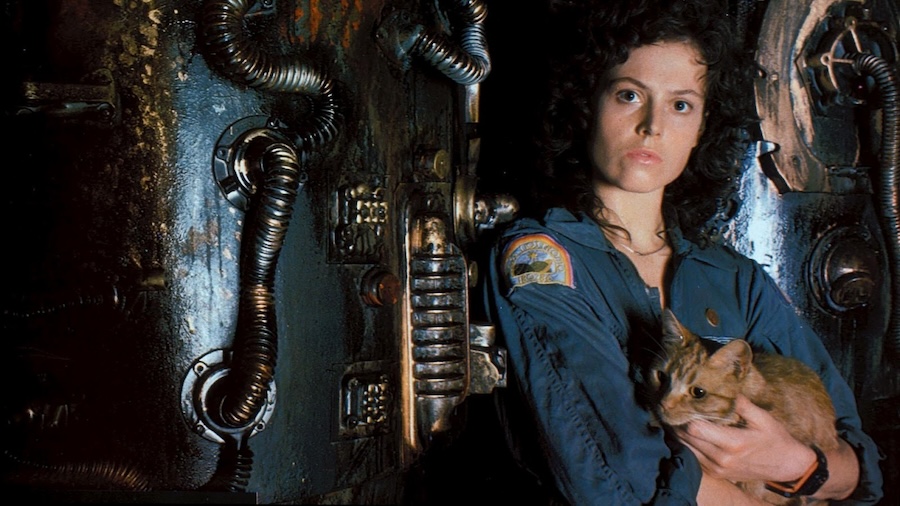
IN SPACE, NO ONE CAN HEAR YOU SCREAM!

The most famous sequence of this horrifying classic takes place about thirty minutes into the story. Everyone is relaxing after a somewhat gut-wrenching experience. They’re all enjoying breakfast together and spirits are high. Suddenly, one of them is choking and starts convulsing violently. Something explodes inside his chest. There’s blood. Then another explosion and something bursts through. A sinister creature rises from the dead man who carried it in his body, and then dashes off. A bold, outrageous sequence that truly shocked moviegoers in the late 1970s, it’s made its way into the history of cinema. Nothing else here is quite as surprising as that chest-bursting scene. That’s because Alien is reminiscent of so many other films. It! The Terror From Beyond Space (1958) is the most obvious example, but there are echoes of The Thing From Another World (1951) and Dark Star (1974), which Dan O’Bannon also wrote.
Much of what goes on on in Alien is quite familiar, but there are many reasons why Ridley Scott’s breakthrough piece has become a classic, in turn inspiring many inferior films.
Answering a distress signal from a remote planet
The story is really simple but incredibly effective. Sometime in the future, the Nostromo, a commercial spacecraft, interrupts its journey back to Earth to answer a distress signal from a remote planet. There they discover a colony of eggs and one of the crew members, Kane (John Hurt), is subjected to a creature that bursts out of one of the eggs and attaches itself to his face. His colleagues take him on board the Nostromo, but do not realize that the “facehugger” will spawn a monster threatening to wipe out everyone on the ship.
From there on it’s just a nightmare because there is nowhere to run; aspects of the production design feel dated, but the confined spaces are expertly used by Scott and his cinematographer. You can virtually see the cast starting to feel a bit claustrophobic, and Jerry Goldsmith’s excellent music score keeps our spines chilled.
More than just a technical triumph
The film is darkly lit to maintain the illusion. The artist H.R. Giger was hired to create the design of the ghastly alien and he’s done a fantastic job. This is one big, fast, icy, black cockroach with acid for blood, but cinematographer Derek Vanlint has done his best to keep the monster in the dark as much as possible. Sometimes it’s obvious that the monster is really just a guy in a rubber suit, but we never get a good look at it and that fact only increases our fear of it. Alien is however more than just a technical triumph. In the end, the sole survivor turns out to be a rather unsympathetic woman who at first doesn’t seem to be very important to the story at all – that’s very clever. The film boasts a wonderful ensemble performance. Sigourney Weaver’s contribution is harsh and effective; Ian Holm is great as the Nostromo’s science officer who gives the crew a startling surprise.
What should we primarily remember from this film? Perhaps just the intense feeling of terror.
There are many memorable sequences here – the crew slowly waking up from their hypersleep, the absurd “birth at breakfast”, Harry Dean Stanton’s dripping encounter with the monster and Weaver’s final showdown with it in the emergency shuttle. But what should we primarily remember from this film? Perhaps just the intense feeling of terror. There’s a monster that we don’t quite know how to explain, there’s a lot of running away from it in dark corridors. Nightmares are fascinating and Alien is just as absurd, scary and eerily inevitable as anything invented by a sleeping mind.
Alien 1979-U.K.-U.S. 117 min. Color. Widescreen. Directed by Ridley Scott. Screenplay: Dan O’Bannon. Cinematography: Derek Vanlint. Music: Jerry Goldsmith. Production Design: Michael Reynolds. Visual Effects: H.R. Giger, Carlo Rambaldi, and others. Cast: Tom Skerritt (Dallas), Sigourney Weaver (Ellen Ripley), John Hurt (Kane), Ian Holm, Harry Dean Stanton, Yaphet Kotto, Veronica Cartwright.
Trivia: Co-producer Walter Hill was the first choice as director. The film was re-released in 2003 with a few changes. Followed by four sequels, beginning with Aliens (1986), and a prequel, Prometheus (2012). The monster also appeared in Alien vs. Predator (2004).
Oscar: Best Visual Effects. BAFTA: Best Production Design, Sound Track.
Quote: “You still don’t know what you’re dealing with, do you? Perfect organism. Its structural perfection is matched only by its hostility.” (Holm)
Last word: “All the shots of the space ship were basically a dolly being pushed with a good steady hand underneath the bloody model. So it was actually all hand-made. But in a funny kind of way, you get very clever when there is very little money, because it makes you think – there’s a big lesson there, somewhere. So when you complain about your CGI budget, think about that.” (Scott, CineFantastique)
